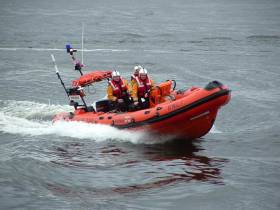Displaying items by tag: Renville
Galway Lifeboat Tows Vessels To Safety At Renville
#RNLI - Galway RNLI's lifeboat was launched on Saturday evening (20 August) after two yachts and a half-decker got into difficulty at Renville on Galway Bay.
The alarm was raised by the Irish Coast Guard shortly after 6pm after a 40ft yacht, a 32ft yacht and a 25ft half-decker ended up on the shore at New Harbour.
Although conditions were rough with choppy waters and Force 6 winds, Galway RNLI's volunteer crew managed to tow all three vessels to safety, assisted by crew on the vessels.
The lifeboat crew first towed the half-decker to safe waters and deployed its anchor before towing the two yachts, one behind the other, out to the half-decker, tying one of them to the smaller vessel so that they could tow the other to a safe mooring.
The crew then repeated this operation with the second yacht, untying it from the half-decker and towing it to a safe mooring. Finally they towed the half-decker back to the quay at Galway Bay Sailing Club.
No one was injured in the incident and only minor damage was caused to one boat.
"This rescue operation took quite some time as the weather conditions were not very favourable," said Galway RNLI lifeboat operations manager Mike Swan.
The volunteer crew on this call out were helm Kieran Oliver, John O’Sullivan, Leanna McHugh and Greg Cullen.
Townhouse Adjacent to Charms of Galway Bay
#WATERFRONT PROPERTY - New to the market is an impressive two-bed townhouse adjacent to Galway Bay Sailing Club in Oranmore, which should appeal to anyone with dreams of sailing out west.
As highlighted in the Galway Independent, 15 Renville Court is set in the grounds of Galway Bay Golf Club, just 20 minutes away from Galway city centre and nestled between the charms of Galway Bay and Renville National Park.
The two-storey residence is situated in a quiet and private cul-de-sac and is decorated to a high standard. Accommodation comprises a spacious open plan kitchen/diner/sitting room, two bedrooms (one ensuite) and a main bathroom, with wooden floors throughout.
Viewing is highly recommended by agents Rooney Auctioneers, who have set an asking price of €150,000. More details including images are available HERE.

























































